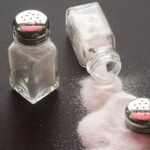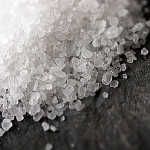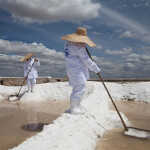
Refined Salt
First of all, it is necessary to understand that any table salt, regardless of its origin, will be considered refined when it goes through a process of washing, grinding, centrifuging and then drying at a high temperature. Then, through sieving, the “impurities” are separated and removed.
Later, other compounds are added for stabilization, coloring and anti-humectants to make it looser. This entire process removes natural iodine, which is added with the insertion of potassium iodate, as it is mandatory by law in Brazil there is iodine in table salt. The intention of this law is to prevent goiter, a disease that occurs in the thyroid and is related to the decrease or absence of iodine in the body.

Coarse salt
Coarse salt does not go through a refining process like fine salt, it is obtained by mineral extraction or through the concentration and drying of seawater. That's why it has larger crystals typical of coarse salt. Coarse salt normally does not have chemical additives. It is also possible to obtain coarse salt through the successive recrystallization of refined salt.

Sea salt
Sea salt is not necessarily taken directly from the sea, although salt deposits are ancient reservoirs of sea water that have dried up over time, but the term may erroneously refer to a type of salt extracted directly from sea water. It is a name that generally determines a type of process used in the production of salt for sale, maintaining physical and chemical characteristics that are not available in refined table salt.
O "sea salt” is dried naturally, in the sun, therefore it does not go through the industrialization processes of refined salt, which maintains the natural iodine and avoids the insertion of additional compounds, in other words, sea salt does not go through any refining procedure. Consequently, it is thicker, less white in color and more humid.

Himalayan pink salt has this color due to the presence of iron oxide. Despite being very beautiful, it doesn't have a very different flavor from other types of sea salt found. There is a high amount of minerals, but for this to make a difference to health, the amount to be consumed would have to be exorbitant. It is healthier to use sea salt, but it cannot be used as a mineral supplement.
Salt flower
This name is widely used by chefs, but, after all, What is “flower of salt”? It is the thin layer of crystals that forms on the surface of salt flats, which many claim has an unparalleled flavor. This type of salt can have different colors formed by minerals or algae typical of each region where fleur de sel is taken. It normally contains compounds that are not present in other types of salt used in cooking, which, in theory, provides the “unmatched” flavor. Just try it to find out!

Read more about what is fleur de sel.




[…] recipe you will learn how to make a delicious brisket tip in the pressure cooker using only coarse salt. It is not necessary to use water, oil or any other type of ingredient, this […]
[…] Sea salt, coarse salt and fleur de sel […]
Good morning
I intend to purchase table salt in 1kg packages. Where can I buy it and how much can it cost for 1 container of 20 Pes? The order is for Mozambique – Maputo.
Himalayan salt is not from the Himalayas but imported from Pakistan, and sold at exorbitant prices here in Brazil...
I bought a salt much thicker than the totally virgin barbecue salt at the farm, it even has pieces of stones with salt eyes glued on it, a wonderful food, I paid for 25 kl 7.90
Good morning, Marcos, where can I buy this salt?
I bought my pure salt at the livestock farm, it is so virgin that it has some pieces of sea stones and is very thick, it arrives stoned and very light, I paid 9.90 for 25 kl, not because it is cheap and for the benefit I am happy
I read and reread the article and couldn't find the difference between coarse salt and sea salt. It's certainly a way for scoundrels to sell our old and traditional coarse salt much more expensive to stuck-up people.
As for fleur de sel, there must be very few brands selling only the surface crystals, the vast majority must use the same coarse salt that is sold for barbecue.
And long live marketing!
I still have the doubt... are sea salt and coarse salt the same thing?
I'm looking for salt in thick stones, that is, larger than barbecue salt, how do I purchase it?
You should find salt suppliers (of all types) on the website mfrural.com.br. It is a classifieds site aimed at producers, creators and small industries.
Go to a market that sells all kinds of spices, like Mercadão Municipal and look for coarse sea salt. I found it in stones measuring 1 cm maximum mixed with smaller coarse salt. I tried to place the salt stones behind the door as a way to catalyze negative energy
Thanks for the tip on the filter, I'm setting up a marine aquarium, with coarse salt from salt pans in Cape RJ, and deionized fresh water, I believe it will work, I'm already cycling the water, the salt costs 10.00 R$ for a large bag + or – 60kl, fleur de sel pot 500g, 25.oo R$, will adding water to coarse salt have the same properties as sea water?
Pedro Miura, was your marine aquarium cycling successful? What kind of salt did you use!?
Email me about your experience, thanks
Berg-ti5@hotmail.com
Good morning, it is generally found in cooperatives where products for farms and farms are sold. And it costs between 9.00 and 12.00 reais for a 25 kg bag, it's actually a wonderful sea salt with more than eighty minerals. I hope I helped, hugs.